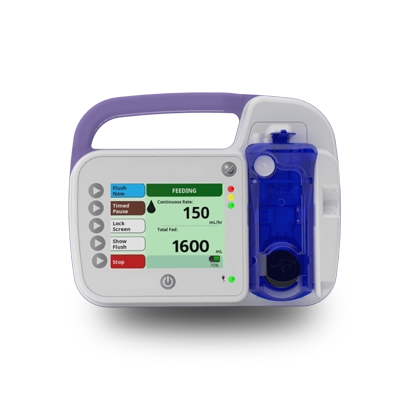Feeding Pump Selection Guide: Finding the Right Solution
Compare different enteral feeding pump options and discover which system best meets your specific needs, lifestyle, and medical requirements.

Why Choose a Feeding Pump?
Enteral feeding pumps provide precise, controlled delivery of nutrition, making them essential for many patients requiring tube feeding. Unlike gravity feeding, pumps offer accurate flow rates, reduce the risk of complications, and provide greater flexibility in feeding schedules. Understanding the different types of pumps available will help you make an informed decision about which system best meets your needs.
Key Advantages of Pump Feeding:
- • Precise flow rate control (typically 1-999 mL/hour)
- • Consistent nutrient delivery
- • Reduced risk of aspiration and gastric residuals
- • Better tolerance for continuous feeding
- • Alarm systems for safety monitoring
- • Ability to program complex feeding schedules
Types of Enteral Feeding Pumps
1. Volumetric Pumps
These pumps deliver a specific volume per hour and are the most commonly used type for enteral feeding. They use peristaltic mechanisms to push formula through specialized tubing.
Advantages:
- • Highly accurate flow rates
- • Comprehensive alarm systems
- • Can handle high-viscosity formulas
- • Multiple programming options
- • Battery backup for portability
Considerations:
- • Larger and heavier than syringe pumps
- • Requires specific pump tubing sets
- • More complex operation
- • Higher initial cost
- • Regular maintenance required
2. Syringe Pumps
Smaller, portable pumps that use large syringes (typically 60mL) to deliver formula. They're ideal for bolus feeding or small-volume continuous feeding.
Advantages:
- • Compact and lightweight
- • Excellent for bolus feeding
- • Simple operation
- • Lower cost
- • Uses standard syringes
Considerations:
- • Limited volume capacity
- • Frequent refilling required
- • Less suitable for continuous feeding
- • Basic alarm functions
- • May not handle thick formulas well
Popular Feeding Pump Models
Infinity EnteraLite Pump
A versatile, user-friendly pump suitable for both home and clinical settings. Features intuitive controls and comprehensive safety features.
Key Features:
- • Flow rates: 1-999 mL/hour
- • Volume delivery: 1-9999 mL
- • 24-hour battery life
- • Lightweight (2.2 lbs)
Best For:
- • Home enteral feeding
- • Continuous feeding
- • Adult and pediatric patients
- • Active lifestyles
Considerations:
- • Requires specific pump sets
- • Regular calibration needed
- • Training required for operation
Kangaroo ePump
An advanced feeding pump with smart technology features, designed for both hospital and home use with enhanced safety protocols.
Key Features:
- • Flow rates: 1-999 mL/hour
- • Smart pump technology
- • Integrated drug library
- • Wireless connectivity options
Best For:
- • Complex feeding regimens
- • Patients requiring monitoring
- • Healthcare facilities
- • Tech-savvy users
Considerations:
- • More complex interface
- • Higher cost
- • Advanced training needed
Compat Enteral Syringe Pump
A portable syringe pump ideal for bolus feeding and small-volume deliveries. Perfect for patients who need flexibility and mobility.
Key Features:
- • Uses 60mL syringes
- • Flow rates: 0.1-99.9 mL/hour
- • Ultra-lightweight (8 oz)
- • Simple operation
Best For:
- • Bolus feeding
- • Medication delivery
- • Pediatric patients
- • Travel situations
Considerations:
- • Limited volume capacity
- • Frequent refilling needed
- • Not ideal for continuous feeding
Factors to Consider When Choosing a Pump
Selection Criteria Checklist:
Medical Factors:
- □ Type of feeding (continuous vs. bolus)
- □ Formula viscosity and type
- □ Feeding tube size and location
- □ Patient's tolerance and medical stability
- □ Required flow rate accuracy
- □ Feeding schedule complexity
Lifestyle Factors:
- □ Mobility requirements
- □ Home vs. facility use
- □ Caregiver technical comfort level
- □ Travel frequency
- □ Insurance coverage
- □ Support and training availability
Essential Pump Features
Safety Features
Occlusion Detection:
Alerts when tube is blocked or kinked, preventing pressure buildup
Air-in-Line Detection:
Prevents air from entering the feeding tube
Low Battery Warning:
Ensures uninterrupted feeding with advance notice
Volume Completion Alert:
Notifies when programmed volume is delivered
User-Friendly Features
Interface Design:
- • Large, clear display screen
- • Intuitive button layout
- • Easy-to-read icons and text
- • Simple programming steps
Practical Features:
- • Carrying case or bag included
- • Pole clamp for stationary use
- • Quick-loading mechanism
- • Memory for favorite settings
Insurance Coverage and Costs
Most insurance plans, including Medicare and Medicaid, cover enteral feeding pumps when medically necessary. Coverage typically includes:
Typically Covered Items:
- • Pump rental or purchase
- • Pump tubing sets
- • Enteral formulas
- • Feeding bags and accessories
- • Regular maintenance
- • Pump replacement as needed
- • Training and education
- • 24/7 technical support
Getting Started
Selecting the right feeding pump is a collaborative decision involving your healthcare team. The process typically includes:
- Medical assessment by your physician and dietitian
- Pump selection based on your specific needs
- Insurance authorization and benefit verification
- Comprehensive training on pump operation and troubleshooting
- Home setup and initial monitoring
- Ongoing support and equipment maintenance
Ready to Find Your Perfect Feeding Pump?
Our enteral nutrition specialists can help you evaluate pump options, coordinate insurance coverage, and provide comprehensive training and support.